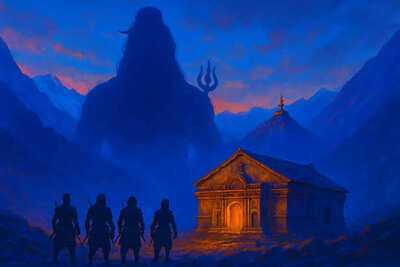 For millennia, mountains have been more than just landforms in India. They are seen as the pillars of creation, connecting the earthly to the divine. In the Hindu tradition, a mountain is not merely stone and soil but a living presence, often worshipped as a deity or considered the home of one. This belief arises from the ancient understanding that the sacred resides in nature itself, and towering peaks are gateways to higher states of consciousness. Pilgrims have walked barefoot on these rocky paths, sages have meditated in their caves, and scriptures have sung their praises.
For millennia, mountains have been more than just landforms in India. They are seen as the pillars of creation, connecting the earthly to the divine. In the Hindu tradition, a mountain is not merely stone and soil but a living presence, often worshipped as a deity or considered the home of one. This belief arises from the ancient understanding that the sacred resides in nature itself, and towering peaks are gateways to higher states of consciousness. Pilgrims have walked barefoot on these rocky paths, sages have meditated in their caves, and scriptures have sung their praises.
 Mount Kailash stands unmatched as the most sacred mountain in Hinduism, Buddhism, Jainism, and Bon. In Hindu belief, it is the eternal abode of Lord Shiva and Goddess Parvati. The mountain is described in the Puranas as the axis mundi, the cosmic pillar that holds together heaven and earth. It rises 6,638 meters and is considered unclimbable, not merely due to physical difficulty but because of its sanctity. No one has ever stood on its summit, and the belief is that only those free from all karma can truly approach its peak. Pilgrims instead perform the Kailash Parikrama, a 52-kilometer circumambulation, considered one of the most spiritually rewarding acts a human can perform.
Mount Kailash stands unmatched as the most sacred mountain in Hinduism, Buddhism, Jainism, and Bon. In Hindu belief, it is the eternal abode of Lord Shiva and Goddess Parvati. The mountain is described in the Puranas as the axis mundi, the cosmic pillar that holds together heaven and earth. It rises 6,638 meters and is considered unclimbable, not merely due to physical difficulty but because of its sanctity. No one has ever stood on its summit, and the belief is that only those free from all karma can truly approach its peak. Pilgrims instead perform the Kailash Parikrama, a 52-kilometer circumambulation, considered one of the most spiritually rewarding acts a human can perform.
 Radha after Krishna Located near Mathura in Uttar Pradesh, Govardhan Hill is not just associated with Krishna’s childhood pastimes but is worshipped as Krishna himself. According to the Bhagavata Purana, when Indra unleashed torrential rains on Vrindavan, Krishna lifted this modest hill on his little finger to shelter the villagers. Since then, Govardhan is revered as a divine manifestation. The hill is only about 80 feet high, yet it holds immense spiritual significance. Pilgrims undertake the Govardhan Parikrama, a 21-kilometer circumambulation, believing that every stone of this hill embodies Krishna’s presence. Unlike towering peaks, Govardhan teaches that divinity does not require grandeur; even the smallest mound can be a god’s eternal home.
Radha after Krishna Located near Mathura in Uttar Pradesh, Govardhan Hill is not just associated with Krishna’s childhood pastimes but is worshipped as Krishna himself. According to the Bhagavata Purana, when Indra unleashed torrential rains on Vrindavan, Krishna lifted this modest hill on his little finger to shelter the villagers. Since then, Govardhan is revered as a divine manifestation. The hill is only about 80 feet high, yet it holds immense spiritual significance. Pilgrims undertake the Govardhan Parikrama, a 21-kilometer circumambulation, believing that every stone of this hill embodies Krishna’s presence. Unlike towering peaks, Govardhan teaches that divinity does not require grandeur; even the smallest mound can be a god’s eternal home.
 Ganesha circled parents, declaring them the entire universe. The Himalayan peak of Nanda Devi, standing at 7,816 meters, is worshipped as the abode of Goddess Nanda, considered a manifestation of Parvati. Revered as the tutelary goddess of Uttarakhand, Nanda Devi represents prosperity, protection, and the fierce power of the feminine divine. The mountain is at the heart of the Nanda Devi Raj Jat Yatra, a 280-kilometer pilgrimage that takes place every 12 years and lasts nearly three weeks. It is one of the most challenging pilgrimages in India, symbolizing the goddess’s journey to her in-laws’ home. Nanda Devi is more than a peak; she is the living mother goddess of the region, venerated with the same intimacy as a family deity.
Ganesha circled parents, declaring them the entire universe. The Himalayan peak of Nanda Devi, standing at 7,816 meters, is worshipped as the abode of Goddess Nanda, considered a manifestation of Parvati. Revered as the tutelary goddess of Uttarakhand, Nanda Devi represents prosperity, protection, and the fierce power of the feminine divine. The mountain is at the heart of the Nanda Devi Raj Jat Yatra, a 280-kilometer pilgrimage that takes place every 12 years and lasts nearly three weeks. It is one of the most challenging pilgrimages in India, symbolizing the goddess’s journey to her in-laws’ home. Nanda Devi is more than a peak; she is the living mother goddess of the region, venerated with the same intimacy as a family deity.

Shri Mata Vaishno Devi Shrine Board refutes misleading media claims
In the Trikuta Hills of Jammu lies the holy cave of Vaishno Devi, one of the most visited pilgrimage sites in India. The hills are considered the abode of Goddess Vaishno Devi, who is believed to have meditated here before merging into a rock formation inside the cave. Pilgrims climb nearly 13 kilometers from Katra to reach the sanctum where the goddess is worshipped in her three natural rock forms called pindis, representing Mahakali, Mahalakshmi, and Mahasaraswati. The Trikuta Hills hold deep mythological importance, with scriptures describing them as among the peaks that emerged during the churning of the cosmic ocean.